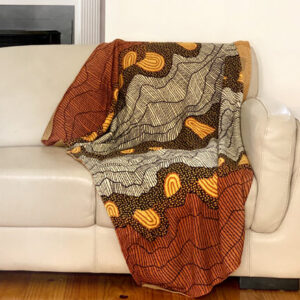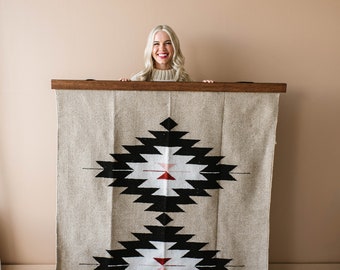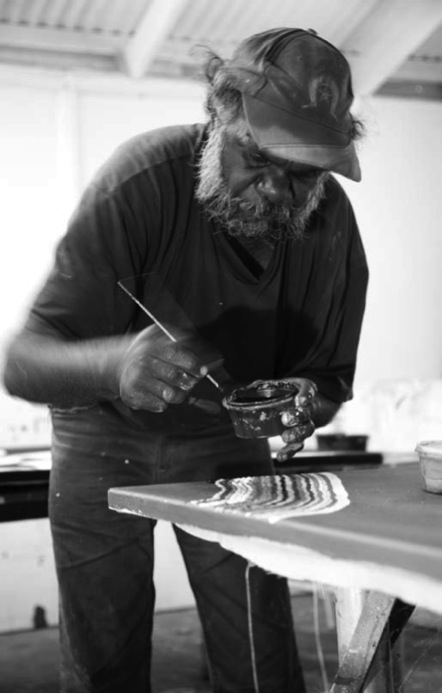Rug, Wall good Hanging, S, Wool, Aboriginal Design, Chainstitch, Kashmir, Australia, Fair Trade, Samuel Miller, APY Lands, Living Room, Home
These beautiful woollen embroideries work equally well as floor rugs and wall hangings.
Chain-stitched kilims are a traditional rug making technique from Kashmir. As people sat on the floor they were both homewares and decoration.
The designs are by Australian Aboriginal artists, they are then chain-stitched in wool onto a canvas backing each cushion cover is an interpretation of an original artwork, usually a painting.
Front of each rug is wool embroidered onto a cotton canvas and back is cotton canvas with a non-slip surface.
Each rug has a flap on one of the shorter sides for hanging portrait style, simply slide a piece of dowel or curtain rod in and hang. As the artworks are painting on the ground most of the images do not have a set orientation good so can also be hung landscape if preferred.
*
These are surprisingly hard-wearing and I use them as both rugs and as and beautifully textured affordable works of art.
Limited Edition: Each rug is individually numbered and shipped with an individual document of Authenticity that gives provenance. No more than 100 rugs will ever be made in this design and size.
*
Artist: Samuel Miller
Title: Ngayaku Ngura
*
SIZE:
Rectangular: 61 cm (24 inches) x 91.5 cm (36 inches)
Composition: wool (front) and cotton (back)
Color: the color is accurate but more nuanced in real life
*
CARE INSTRUCTIONS:
Do not put place/use in direct sunlight or colors may fade. To clean - careful hand-wash in warm water using a wool detergent. Can be ironed on a wool setting.
*
The artist: Samuel Miller
Samuel Miller was born in 1966 at Ernabella Mission. When Samuel's mother passed away, his father's second wife, Molly Nampitjin Miller, cared for him. Molly is a founding director of Ninuku. When growing up, Samuel moved between Amata and Pipalyatjara, but he now resides in Kalka with Molly and the rest of her family. A committed artist, Samuel usually paints every day. His paintings depict the traditional iconography of his land, which lies to the east of Pipalyatjara - rock holes, creeks and hills feature in his work, all immersed in Tjukurpa (Dreaming stories). Samuel's paintings are mesmerising. His composition is minimalist and he makes extensive use of radiating colours, which are largely drawn from the varying colours in the landscape surrounding his country. He is fastidious in his approach and works with a large number of paint colours, which he spreads out around him as he paints. Although he is one of the youngest men painting at the art centre, Samuel is confident and focused in his approach.
*
About the design: Ngayaku Ngura (Country/home belonging to me)
Ngayuku Ngura means ‘My Place'. Samuel uses an extensive palette of colours to paint the country surrounding Kalka and Pipalyatjara. His paintings feature the various land formations from that area – rockholes, creeks and hills. His land includes a sacred men's rockhole, so sacred that the name is not allowed to be written down or spoken about.
*
About the BWA chainstitch kilim products
These beautiful, unique textiles are a cross-cultural collaboration combining Aboriginal designs and traditional Kashmiri rug-making techniques. Chain stitched, using hand dyed wool, each is a completely handmade piece. A more empowering way to work, this brings many direct benefits to the artists' and their community. Control and ownership of intellectual property are also maintained. Purchase of these products guarantees a direct return to the Aboriginal artist and their community.
*
About my connection wtih Better World Arts
I met founder of BWA in 2004 whilst doing a consultancy in the APY Lands preparing marketing plans for five art centres for Ananguku Arts. I was gobsmacked by this terrific fair trade project that Kaltjiti Arts was then doing with Caroline Wilson. As a textile nut, the artisan skills and use of wool appealed to me and the rendering of Indigenous designs in rugs and cushion covers is so lovely. I later encouraged them to work with other art centres and introduced them to Warlukurlangu Artists and Injalak Arts. Flick (founder of Flying Fox Fabrics)
*
BWA
Better World Arts has been operating for over two decades. Our role models were Oxfam, Fred Hollows (the Fred Hollows Foundation) and Anita Roddick (The Body Shop).
We work with traditional artisans from remote regions in Kashmir, Peru, West Bengal, Uttar Pradesh and Nepal (Tibetan refugees). More recently we have started working with China, making bone china and silk ties.
We work with Australian AJ boriginal artists from remote communities across Australia, from Arnhem Land to Central and the Western Desert regions, from rural locations and from cities.




